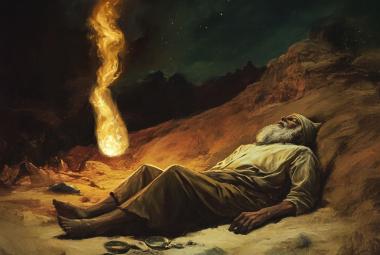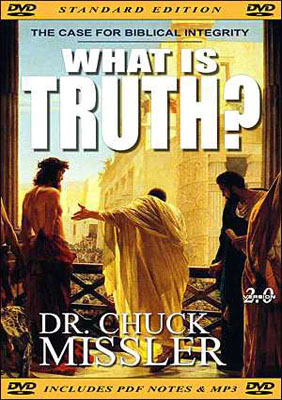The Basic Challenge Before Us All
What is truth? That was the rhetorical question of Pontius Pilate when he was facing Truth, in Person. Like Pilate, we are all faced with this basic challenge: “What is truth?” Perhaps that question can be refined even more, to the most crucial question: “How do we know the Bible is true?”
The first step is to recognize today’s skeptical environment. There are attacks on every side for the very existence of truth. Society espouses relativism by saying, “You have your truth; I have mine.” This is accompanied by attacks on the Bible itself—the very fountain of truth for mankind, the very basis of our heritage. Of course, there are also attacks on the Lord Himself.
This is all happening with a cosmic warfare going on in the background. Scripture makes it clear that we are faced with spiritual adversaries whose principal weapons are deceit and doubt. That was Satan’s first move in the Garden of Eden. To ask the question, “Hath God said?” raises doubts that God really said what He said. That strategy echoes throughout the centuries and is very, very pervasive in our civilization today.
So how do we know the Bible is true? The traditional approach to defending the Bible tends to be a bit scholastic. There is another approach that uses branches of science that would not commonly be connected with the Bible. It’s quite astonishing to realize how the discoveries of modern science in just the last century have totally altered our understanding of the reality in which we live. This approach is an exploration of the very boundaries of what we think of as reality.
It may seem strange, but this approach will even require consideration of messages from outside the boundaries of our reality. These are messages that are extra-terrestrial; they actually have their origin outside the space-time of earth. There are also some hidden discoveries in the Biblical text itself that may be surprising.
This is the rather unorthodox line of inquiry that we will use as we examine the basis for having confidence in the Bible.
Attacks on Truth
There are attacks from the pagan left that are very organized, very sinister, and possibly motivated supernaturally. One attack comes from a very popular book, The Da Vinci Code,by Dan Brown.[1]
This is a very readable, and very cleverly crafted, novel. Although it masquerades as a novel, it confronts the reader with a fact sheet in the front of the book with three paragraphs claiming that these things are true and accurate when they’re not; they’re deliberate deceptions. The statements are not accidental misunderstandings, but a deliberate attempt to deceive, confuse, and disrupt the faithful.
That book has given rise to a whole cottage-industry of rebuttals. Anyone interested in a rebuttal has an abundance of books to help them sort out the various premises and misinformation that pervade Dan Brown’s colorful, but blasphemous, novel.
Despite that, The Da Vinci Code was heralded by the press. “A masterpiece that should be mandatory reading,” says The Library Journal, “a compelling blend of history and page-turning suspense.”[2] “An exhaustively researched page-turner” was the quip from Publisher’s Weekly.[3] That’s astonishing, because it is full of misinformation and twisted history.
To make matters even worse, a major blockbuster movie by Ron Howard was released under the same name.[4] This is very much launching a tsunami across our culture; it’s certainly raising questions, feeding the skeptical and confusing the marginally faithful.
The situation should challenge those of us who take the Bible seriously to really understand its origins and its foundation.
While all this is going on, the National Geographic joined in the exploitation. In their May issue of 2006, they featured an article on The Gospel of Judas.[5] They were obviously exploiting, as best they could, the groundswell from the Da Vinci movie, which was being released that same month.
The National Geographic had a very slick presentation, very skillfully designed to undermine traditional Biblical beliefs. The Gospel of Judas, which is the subject, was discovered in the 1970s. It was known at the time that Irenaeus refuted it back in 180 A.D.;[6] so this is neither new, nor newsworthy. It is certainly not historical, but it’s among those documents that are used to confuse people who don’t read and know their Bible.
Mel Gibson directed a movie called The Passion of the Christ.[7] His reviews were a little different than Dan Brown’s. The New Republic said, “A repulsive masochistic fantasy, a sacred snuff film.”[8] “Courting bigotry in the name of sanctity,” was the comment in the New York Times.[9] “A real nut case whose ulterior motive was making money,” said 60 Minutes.
The contrast here is something strange. The deliberate deceptions of The Da Vinci Code are ignored by these reviewers; they seem to collude with Brown in his attempts to undermine the veracity of the Bible. The attacks on The Passion of the Christ expose a bias against the truth. How else can we explain the portrayal of an historical event as “masochistic fantasy,” while the fictitious marriage of Jesus and Mary Magdalene can be called “researched material fact”?
Along with Dan Brown and the National Geographic, we have the Jesus Seminar. This gathering was an astonishing array of pseudo-experts who, in the 1980s and 1990s, exchanged subjective, speculative hunches for serious scholarship. Add to that, Peter Jennings’s TV Special, the History Channel’s “The Banned Books of the Bible,” Hugh Schonfield’s The Passover Plot (many years ago, in 1966), and The Last Temptation of Christ in 1960. Even Mel Gibson’s phenomenal movie fails to communicate just who Jesus Christ really is, and that is the crux of the whole issue in the first place.
So what’s going on here? This is a reversal of values. Fiction is promoted as fact, and fact, even the deity of Jesus Christ, is passed off capriciously as mere fiction. Even the undeniable grandeur of the creation itself is attributed, in our schools and in our culture, to the randomness of a cosmic accident. How astonishing—how distant this is from any real grasp of reality.
This excerpt is from Dr. Chuck Missler’s briefing pack What is Truth?, available in video, audio and eBook formats.
Notes:
- Brown, Dan. The DaVinci Code: A Novel. New York: Doubleday, 2003. ↩
- “The Greatest Conspiracy of the Past 2000 Years Is About to Unravel.” Dan Brown. Accessed August, 2014. https://www.danbrown.com/the-davinci-code. ↩
- “Fiction Book Review: THE DA VINCI CODE by Dan Brown, Author. Doubleday. PublishersWeekly.com. Accessed August 18, 2014. https://www.publishersweekly.com/978–0–385–50420–1. ↩
- The Da Vinci Code. Sony Pictures Home Entertainment, 2006. Film. ↩
- Kasser, R. (2006). “The Gospel of Judas: From Codex Tchacos.” Washington, D.C.: National Geographic. ↩
- Ireneus wrote in Doctrines of the Cainites; “They declare that Judas the traitor was thoroughly acquainted with these things, and that he alone, knowing the truth as no others did, accomplished the mystery of the betrayal; by him all things, both earthly and heavenly, were thus thrown into confusion. They produce a fictitious history of this kind, which they style ‘The Gospel of Judas.’” ↩
- The Passion of the Christ. Director: Mel Gibson. Icon Productions, 2004. ↩
- Dowd, M. (2004, February 26). “Stations of the Crass.” The New York Times. Retrieved August 20, 2014, from https://www.nytimes.com/2004/02/26/opinion/stations-of-the-crass.html ↩
- Dowd, M. (2004, February 26). “Stations of the Crass.” The New York Times. Retrieved August 20, 2014, from https://www.nytimes.com/2004/02/26/opinion/stations-of-the-crass.html ↩




